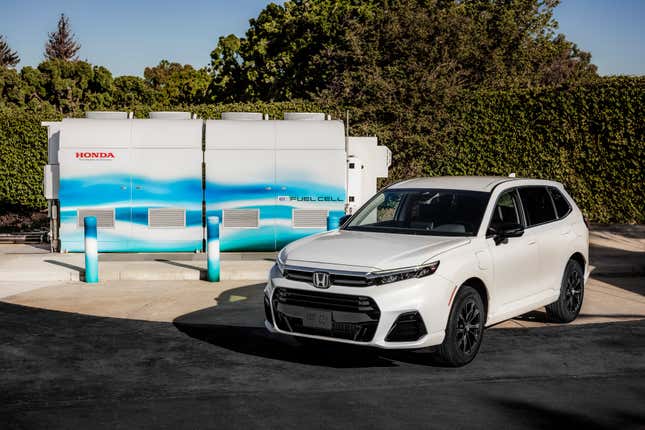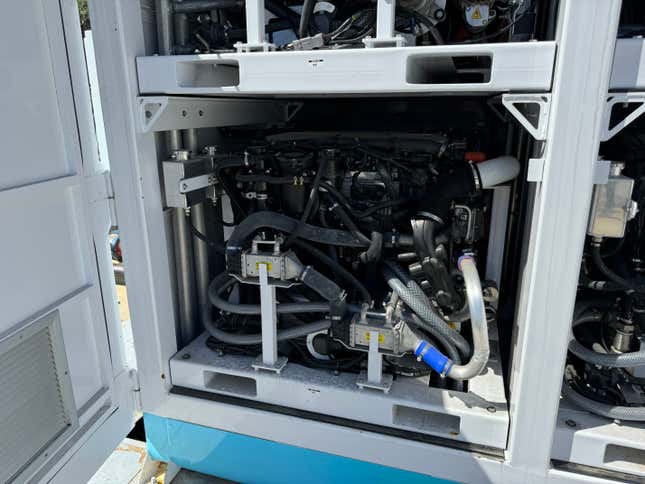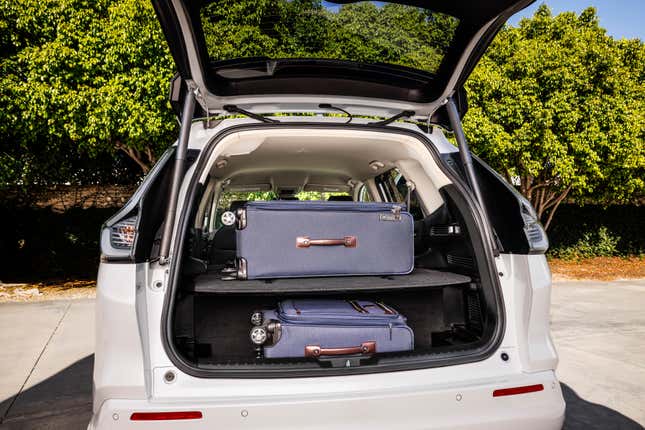It feels like I’ve been hearing that hydrogen cars are the future for my entire life, and that sentiment has yet to manifest itself into actual tangible change. While I now live in California, where hydrogen cars actually exist and are driven by real people, they’re still extremely niche products. Fewer than 3,000 hydrogen fuel-cell cars were sold in the U.S. in 2023, just 0.02 percent of total light-duty vehicle sales. The number of fueling stations is dwindling too — Shell just announced the closure of all of its hydrogen stations — and hydrogen costs are painfully high.
Despite this, Honda recently revealed its next-generation fuel-cell vehicle, the CR-V e:FCEV, Set to only be available in California and only as a lease, the hydrogen CR-V was developed using engineering know-how and customer feedback from the discontinued Clarity. It is a deliberately low-volume model, and Honda knows it seems kinda pointless. Honda’s main goal for the fuel-cell CR-V is to advance the company’s hydrogen technology for much more realistic and important uses, like long-haul trucking and large-scale power generation.. The fact that the CR-V e:FCEV is a much improved and unique offering is just a bonus.
Full disclosure: Honda invited me to its American headquarters in Torrance, California to drive the CR-V e:FCEV on a brief 5-mile route. After being fed lunch I got a tour of the collection hall in the lobby, was able to ride a Motocompacto around a parking lot, and asked executives and engineers questions in a round table with other journalists.
Unlike every other hydrogen car on sale (of which there are very few), the CR-V e:FCEV is actually a plug-in hybrid. In addition to filling it up with hydrogen, which then is converted to electricity to power the 174-horsepower electric motor, the CR-V can be plugged into an EV charger to juice up its 17.7-kWh battery pack. That gives it an all-electric driving range of 29 miles — pretty average in terms of gas-powered PHEVs, but more than enough for daily use. Honda says the CR-V’s powertrain costs a third of what the Clarity’s did, and its reliability has been doubled.

The CR-V can hold up to 4.3 kg of hydrogen, 1.2 kg less than the Clarity, and total driving range is 270 miles, 90 miles fewer than the Clarity. Still, the addition of the plug-in setup makes the CR-V e:FCEV a lot more appealing to a wider range of people. Honda says that 60 percent of hydrogen Clarity customers drive short distances, where fuel cells aren’t very efficient. It’s also a safety net in case of hydrogen shortages or other issues, though admittedly not a huge net. Recharging the battery takes around two hours on a Level 2 charger.
From behind the wheel the e:FCEV drives exactly like you’d expect an electric CR-V to. It’s a good deal quieter than the CR-V Hybrid, and it rides a lot better thanks to all the extra weight lower down in the chassis. The hydrogen CR-V’s steering is heavier, too, which I prefer. Honda hasn’t announced performance figures for the e:FCEV yet; it likely won’t be that much quicker to 60 mph than a CR-V Hybrid, but the instant punch of the electric motor’s 229 pound-feet of torque makes the hydrogen model feel a lot quicker off the line and when merging.

But there are some curiosities with the powertrain. When you start the CR-V it defaults to EV mode, which only uses the batteries to power the motors. While not exceptionally quick by any means it’s plenty of power for around town, but if your right foot demands too much torque, the CR-V will switch to Auto mode, booting up the fuel-cell system. That can take a while, so if you’ve been driving around in EV mode and then suddenly need to merge onto the freeway, you might get stuck with sluggish acceleration as the fuel cells warm up and engage. Honda says that if you know you’ll require more power on your journey, you should put the car into Auto mode in anticipation of when it’ll be necessary. The Auto mode isn’t always using the fuel cells, though — it still prioritizes the use of the electric range.
Honda just transferred over the regenerative braking system from the CR-V Hybrid, so it’s not nearly as nice as what you get in other EVs. Real aluminum paddles behind the steering wheel adjust the levels of regen, and the strongest setting can bring the car to an almost complete stop. If you’re driving in Normal mode it doesn’t save the regen setting you select, instead resetting to no regen after a few seconds of driving. If you put the e:FCEV in Sport mode the car will hold whatever regen level you want, but then you’re stuck driving around in Sport. The powertrain majorly cuts into cargo space, raising most of the cargo floor, but Honda hasn’t given specs yet.
Honda isn’t ready to say how much the CR-V e:FCEV will lease for, but lessees will have a lot of their fuel paid for — Clarity customers got $15,000 worth. That’s a good thing, as hydrogen is currently sitting at around $35 per kg, making filling up the e:FCEV at least twice as expensive as filling up a gas-powered CR-V hybrid. (Honda says the targeted price for hydrogen is one-third of that.) And while there will surely be deals to be had for the hydrogen CR-V, it’ll likely still be pricier than a normal CR-V, and only around 300 will be produced each year.
Part of the reason the e:FCEV will be lease-only is so Honda can reclaim the cars to investigate how they’ve held up and performed in the real world. It did the same with the lease-only Clarity, though apparently so many customers loved their Clarities that Honda kept extending their leases. Honda says it’s expecting more fleet customers to want the CR-V e:FCEV, as it’s a much more practical body style than the old Clarity and the plug-in setup makes it easier to use in more situations. Over the coming weeks Honda is inviting past customers and newly interested parties to come and test drive the CR-V, and some organizations that Honda is talking with have hydrogen filling stations at their locations.

That’s where the CR-V e:FCEV starts to make more sense. Hydrogen just isn’t a feasible solution for passenger vehicles right now, and I don’t think it ever will be. But it has an actual possibility for success in long-haul trucking, delivery vehicles, work trucks and other commercial applications, along with things like power storage and generation. Not only will the CR-V genuinely help with the development of these future vehicles and systems, Honda already has its hydrogen powertrains in use at its own facilities.
At Honda’s American headquarters in Torrance, California, a spokesperson and engineer showed us the hydrogen-powered emergency power generator that’s actually in use on the campus. The huge box uses eight fuel-cell powertrains that were directly nabbed from Clarities, with the capability of delivering up to 500 kW of power. If one of the units goes offline the whole thing can still work, and the system automatically switches on in case of a power outage. Honda says it has 2,000 individual powertrain units coming this year, and use cases like this give powertrain techs a direct pathway to working on the commercial units.
Honda says it wants to grow the infrastructure ecosystem by creating demand, thus justifying more local investments, and the goal is to be making a few hundred thousand of these fuel-cell systems by the end of the decade. The long-term vision is for total cost parity between hydrogen and diesel. These power setups are especially appealing in countries like Japan and South Korea that typically have to import their own energy.

In a roundtable with different executives and engineers following my drive of the CR-V, Honda’s people expressed the classic “chicken or the egg” analogy, saying that it’s investing in both the product and the infrastructure as both need to improve at the same time as demand. “We’re doing this because somebody has to” was a common sentiment among Honda’s spokespeople, with most adding that the technology is rapidly developing, but it can’t expand without cars like the CR-V e:FCEV existing.
For literally 99 percent of the automotive buying public, the Honda CR-V e:FCEV really doesn’t matter. But for those Clarity customers who loved their hydrogen cars so much that they want another, the fuel-cell CR-V is an even better option, and Honda could capture a few dozen new hydrogen-curious customers too. The e:FCEV’s implications for commercial uses are the real reason for its existence, and I’m hopeful that hydrogen vehicles will finally see a surge in use and popularity — even if I won’t ever be driving one.





